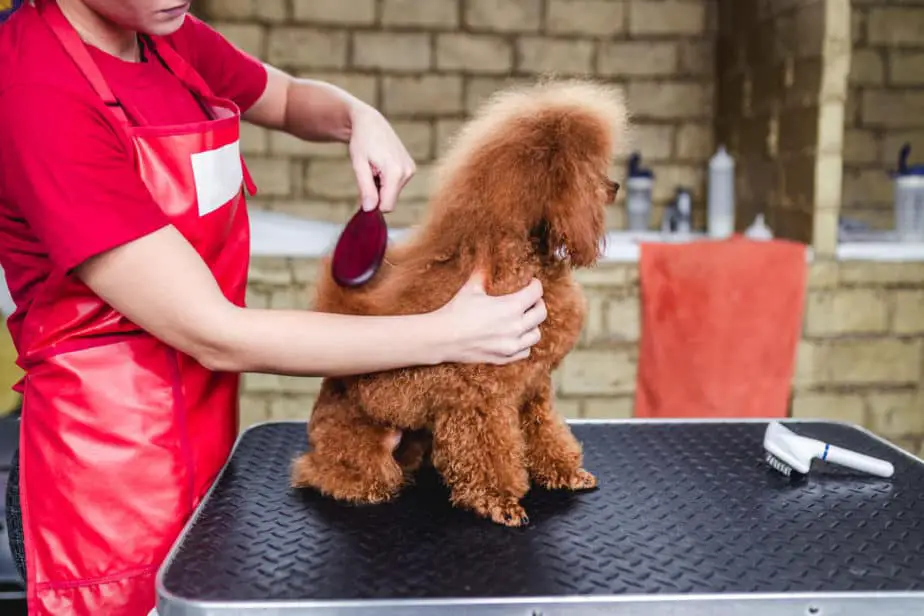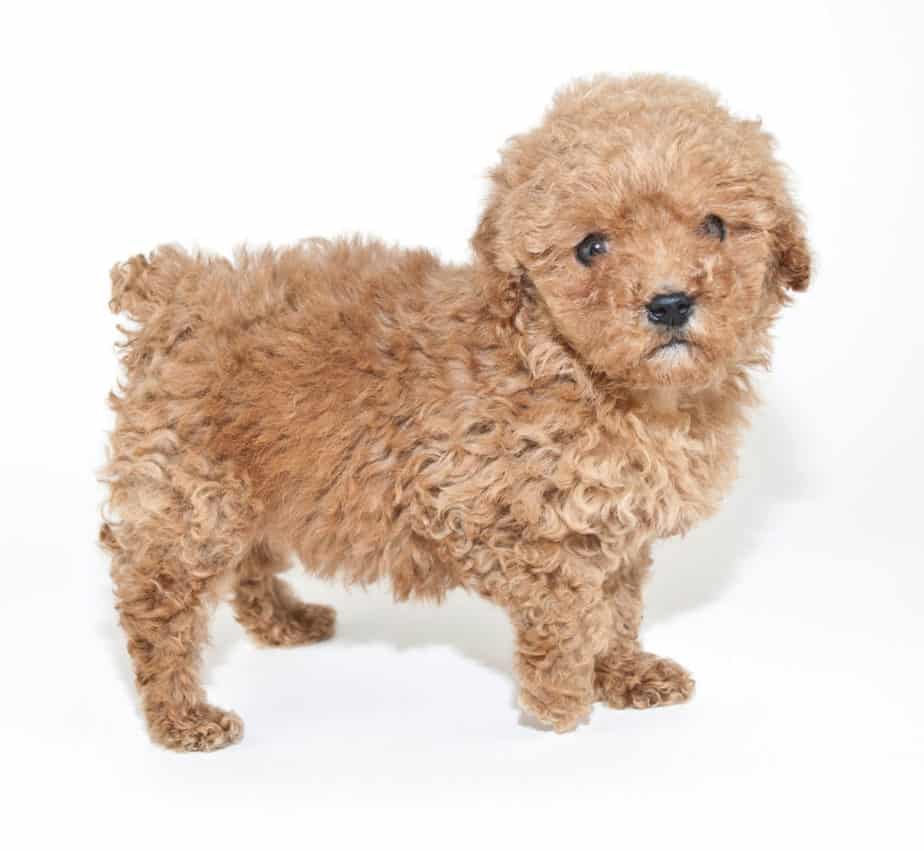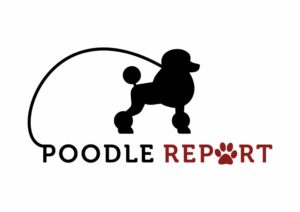
Poodles have extremely distinct fur. Or is it hair? That is a question that is asked of poodle owners and vets frequently. Don’t worry, poodles typically don’t take offense if you get it wrong. Because this has become a popular question, I did some investigating to learn what the proper term for these adorable pups is.
So do poodles have fur or hair, and what is the difference? Poodles have hair, not fur. While most dogs have fur, poodles are one of a handful of breeds that are considered to have hair. Poodles only have a single layer coat that does not shed, and their hair can even respond to hormonal changes in the body, like human hair.
Hair continues to grow, and it does not fall out in large amounts unless there are hormonal changes or underlying issues. Fur only grows to a certain point, and then it needs to fall off and shed. Poodles have a beautiful head (and body) full of silky hair that will function like that of a human.
Differences Between Fur and Hair
At first glance, you may just think, “What’s the difference? I still must brush it. It all works the same, right?” Well, kind of. There are a lot of nuances and minor differences between the two, but at their core, hair, and fur are really the same.
Ross McPhee, of the American Museum of Natural History in New York City, was asked in this article about the differences between hair and fur. When asked if there was a material difference between the two, he stated there was not. The answer he gave his to this question is as follows:
“The way I think a lot of people understand fur versus hair is in the density of follicles. Fur is dense. Whereas hair is not so dense. There’s less of it.” ”
” Ross McPhee , Curator of the Department of Mammalogy at the American Museum of Natural History
If we look at the hair on poodles versus the fur on other dog breeds through that scientific lens, we realize that fur and hair are the same, but they each have their own traits that will vary from person to person and dog to dog.
Both fur and hair are made from keratin, which is a protein compound. Both are genetically similar as well. The differences between the two are based more on how they look, feel, as well as how you care for them.
Texture Differences Between Poodle Hair and Fur
There are real differences in the texture between fur and hair. Dogs with only hair, like poodles, will have a single layer of hair while most dogs with fur have a double layer of fur.
Poodle Hair Texture
Hair tends to be the smoother of the two, and it can grow longer. While fur needs to shed at specific lengths, hair can continue to grow for as long as you allow it to.
Hair can be straight, curly, or wavy and can get tangled easily if you are not careful and pay close attention to their grooming needs.
Dog Fur Texture
Dogs with fur have a top coat and an undercoat giving them that furry, thick feeling. The fur is almost always going to be denser and shorter than hair. This is due to requiring more follicles on their skin for proper fur growth.
The undercoat of fur tends to be a soft, fine coat that helps dogs regulate their body temperature throughout any season. They don’t always have this double coat, but it is a highly common feature for most dogs that have fur.
Both fur and hair each have their challenges and benefits when it comes to grooming. We’ll talk more about grooming needs later in this article.
There are Slight Growth Cycle Differences Between Fur and Poodle Hair
How fur and hair each grow is a significant difference. Their growth cycles offer insight as to why they each have such different looks and feels that result in differing styles of maintaining and caring for each.
Although Poodle hair grows longer, the growth cycle is shorter which results in little to no shedding. Hair and fur do need to pass through the same cycles during growth, but they go at different speeds.
Typical Hair/Fur growth cycle
Typical Hair growth cycle :
1. Anagen
The follicle becomes active.
2. Catagen
The sheath of the root begins to bond with the hair and growth comes to a pause.
3. Telogen
Hair neither grows nor dies off during this dormant phase.
4. Exogen
Hair is shed from the follicle during this phase, and the entire cycle starts over again. When your dog sheds more heavily during the hot summer months, this phase is a much faster process so that they can shed that winter coat.
The anagen phase is the main differentiating factor between hair and fur. Hair needs more time during the anagen phase, slowing the entire process down. But dogs with fur need to get through this process faster, so they can shed adequately and maintain a healthy coat.
If you would like to see pictures and learn more about the different poodle hair types, read this article.
Fun Fact: According to the American Kennel Club, when a poodle is pregnant, she may experience hair loss due to hormonal changes in her body. Her hair may thin during and after having puppies.
Poodle Hair, Fur and Allergies
The debate surrounding dog hair and fur inevitably leads us to allergens. Many people believe dog hair tends to cause fewer allergies, however, it is really not that simple.
The hair/fur itself, isn’t always what causes those allergens. There are a few other things that can cause a reaction in their owners and their families. These can include:
- Different chemical compounds in the skin
- saliva
- Dander
- Dust or pollen in the dog’s coat
- Your dog’s urine
Poodle Hair verses Dog Fur and Allergies
Since poodles have hair, it is typically acknowledged that they are a better breed for people with allergies. But it is not necessarily because of the difference between the fur and hair themselves. There are a few ways to look at this.
A poodle’s curly coat of hair can easily trap dander underneath it, however, a poodle does not shed it’s hair. The build-up of dander just under that layer of hair can cause some damage to anyone who suffers from dander-related allergies. So, for this reason, they need to be groomed frequently to help that dander escape and not cause build-ups.
But on the flip-side, dog fur sheds frequently and holds onto that dander as it spreads about the house. So, when your pup sheds a lot, and you notice your allergies get worse, it is typically not from the excess fur around the house. It is from the dander and protein compounds from their skin that are triggering those sneezes and watery eyes.
Poodle Hair Spreads Less Dander Than Dog Fur
Most dogs with fur tend to shed dander through their fur roughly every 3-4 days. This causes a huge issue for anyone with allergies because there is almost a constant spreading of allergens in the air.
Poodles only shed that dander and unnecessary skin particles roughly every 21 days.
Because of the limited shedding, poodles tend to be a go-to dog breed for anyone who suffers from allergies. But keep in mind, that if your poodle has curly hair, you will want to be sure you do everything you can to control that dander and to keep their hair and skin healthy.
Speak with your groomer about the best shampoos and grooming techniques that will help control that dander and reduce allergies. We’ll be covering some of those tips in the next section as well.
Grooming Tips for Poodle Hair
A significant part of poodle hair care will be preventative. Their curly hair can become unmanageable quickly if you don’t stay ahead of their grooming needs.
Check out this article I recently wrote on 25 haircuts for poodles. in it, you’ll find pictures of the most popular and unique haircut styles for your poodle out there.
Brushing your Poodle

You will want to stick to daily brushing to help keep their hair from matting. Ensuring you are using proper brushing techniques will be equally as crucial for your poodle. If you don’t keep up with their hair maintenance, they can easily matt, which can easily lead to needing to shave them in that area to rectify the situation.
Poodle Brushing Tips
Here are some tips on keeping poodle fur and skin happy and healthy:
- Brush in strokes that are massaging and go all the way down to reach the skin. That action will stimulate circulation. It also helps to remove dander and any unnecessary skin particles that should be removed. Getting down to the skin is extremely important for poodles because their hair can become matted and tangled easily, and it begins at the root.
- Slicker brushes are a commonly used brush for poodles because they can get down to the root easily and help prevent matting. They are tightly spaced and have shorter, thin wires that help penetrate that curly hair.
- Always check for burrs, ticks, or anything else that your poodle may have picked up outdoors.
- Find a daily routine with your poodle so brushing so they become used to it and will begin to welcome it. Poodles are naturally stubborn pups who take pride in being independent, so let them know you’re there for them to help with this routine. It will also help increase the bond between you while keeping them healthy.
Because their hair is a different texture and thickness compare to fur, the right type of brush will be essential. The slicker brush became popular for poodles because it works well with that type of hair.
But some other tools and brushes help keep a coat smooth and shiny like rubbery combs. Those combs can also help remove dead hair. If you own a poodle puppy, read this article to learn more about exactly how and what tools you will need to groom your poodle at home.
If you’re unsure of the type of brush to use on your poodle, check with your veterinarian or groomer, and they will be able to help.
Fun Fact: When poodles are trimmed with those fluffy puffs around their ankles, hips, or other joints, it is meant to help protect them. While many think this look is purely for aesthetics, it is there to function for safety and efficiency. With less fur, they are better swimmers. But if the water is cold, it can make their joints vulnerable. This allows protection for their joints in cold weather and water, while not weighing them down with all their fur.
Bathing a Poodle Helps to Keep the Skin and Hair Healthy
Poodles should be bathed every 4 to 6 weeks. If your poodle loves the outdoors and a good swim in the lake or frolic in the leaves and mud, then this will need to be more frequent. But for most poodles, 4-6 weeks will be the ideal time period.
You don’t want to overdo it, as this can irritate their skin and even harm follicle development. Dogs have natural cleansing abilities that help them maintain their hygiene even without your help. But they need that bath to help release dirt, grime, and dead hair or skin.
You can bathe poodles at home with the proper shampoo and conditioner and enough space to safely have them in a tub. This may be a tall order for some poodles, but others will enjoy the experience as it is relaxing and comforting on their skin. It is also another great bonding experience.
Again, you may want to reach out to your vet or groomer for specific recommendations based on your poodle’s hair and skin needs. But if you plan to groom at home, here are some great things to keep an eye out for in your shampoo and conditioner selection.
- No additional sulfates, parabens, phosphate, or phthalate which can have damaging effects on their skin and overall health.
- Poodles have water-resistant coats, so it needs to be strong and effective enough to penetrate.
- Stay away from soaping agents in the shampoo. We love a good lather when washing our hair, but too much shampoo can dry out a poodle’s skin and cause irritation.
- They should have a stable pH balance between 6.5 to 7.5.
If your poodle suffers from any skin issues, it is essential to check with your vet before moving forward with any at-home bathing.
Do Poodles Have Different Hair as Puppies?

Most dogs have slightly different coats as they go from puppies to adult dogs. For poodles, they tend to transition from a puppy coat to an adult coat between 9-16 months old. This will vary per the type of poodle and the dog themselves. Not all dogs will be on the same timeline, even within the same type.
Because poodles have hair rather than fur, matting will always be an issue. Whether they are a puppy or an adult, you will want to provide daily grooming and proper hair care for them.
Keeping a poodle’s hair short from a young age can be very helpful to maintain their healthy hair and avoid knots. But it can also be a great way to help prevent that dander build-up that can become an issue for poodles.
Fun Fact: Poodles hairstyles vary widely. Many times, if the poodle is a participant in shows through organizations like the American Kennel Club or Westminster, they will have specific rules about their hairstyles.
If they want to compete as show dogs, poodles need one of these hairdos: English Saddle, Continental Clip, or the Modified Continental Clip. And poodle puppies must adhere by the official Puppy Clip, which enforces an even length throughout their body.
Other Dog Breeds That Have Hair, Not Fur
Poodles aren’t alone in this boat. Various other dog breeds have hair rather than fur. Their hair types will be different from poodles, but the single layer of hair rather than double coats of fur remains consistent.
Here are some of the other popular breeds that have hair, rather than fur:
- Portuguese water dog
- Irish water spaniel
- Bearded Collie
- Giant schnauzer
- Xoloitzcuintli (commonly referred to as the Xolo) and Peruvian Inca orchid are mostly hairless, but what they do grow is hair, not fur
- Bedlington terrier
- Kerry blue terrier
- Wirehaired fox terrier
- Standard schnauzer
- Tibetan terrier
- Polish lowland sheepdog
- Bichon fries
- Maltese
- Yorkshire terrier
- Miniature schnauzer
- Shih-
- Tzu
- Havanese
- Bolognese
- Brussels griffon
The Debate Over Poodle Fur or Hair
As much as we want to say that every dog has fur as a knee jerk reaction, poodles do have hair instead. Their curly locks need a lot of attention and maintenance and should be groomed daily. The single layer of hair, rather than a double layer of fur, will help those with allergies if the hair is maintained and cared for properly.
The limited shedding and dander released into the air are a great benefit to those with allergies to pet dander. But remember that at the end of the day, hair and fur come from the same thing. The look, feel, and care needs may be different, but scientifically speaking, they are cut from the same cloth.
Must Have Products For Poodles And Doodles
Thank you for reading this article. I hope you found it helpful. Here are some products that I personally believe every owner should employ to help ensure the best quality of life for their dogs. These are affiliate links, so if you do decide to use any of them, I’ll earn a commission.
But in all honesty, these are the exact products that I use and recommend to everyone, even my own family.
Lemonade Pet Insurance: Lemonade Pet Insurance has enabled me to afford a very high level of veterinary care for my dog, Angus. Even after he was diagnosed with cancer a few years back. Lemonade is a great company, and I can’t recommend them enough!
Brain Training For Dogs: Brain Training for dogs is an amazing online training program I found that actually helped me to understand and ultimately stop my dog’s separation anxiety and destructive behaviors when I left the house. This program actually works, and at a small fraction of the cost of hiring a dog trainer!
Pet Plate: I first learned of Pet Plate when the company was featured on the TV show “Shark Tank” back in 2016. Pet Plate is the dog food subscription service I use to provide extremely healthy, pre-portioned meals for my dog. Pet Plate gives my dog Angus the highest quality nutrition at a very affordable price.
BarkBox: Without a doubt, my dog enjoys Barkbox more than anything else I buy him. BarkBox delivers a customized box of themed toys, treats, and other products to your door each month. In addition, I like that a percentage of proceeds is donated to local animal shelters.
Pawp.com: Pawp is not insurance. It’s a membership program that gives you access to unlimited video calls or texts with a licensed vet 24/7 and includes up to six pets on a single membership! I Purchase this service for my dog Angus and have saved hundreds of dollars over visiting his local vet with questions or more minor health concerns. Pawp will even pay up to $3,000 if your pets experience an emergency situation! Check out Pawp’s website to see why Pawp can help you save money and increase your pet’s quality of care.

